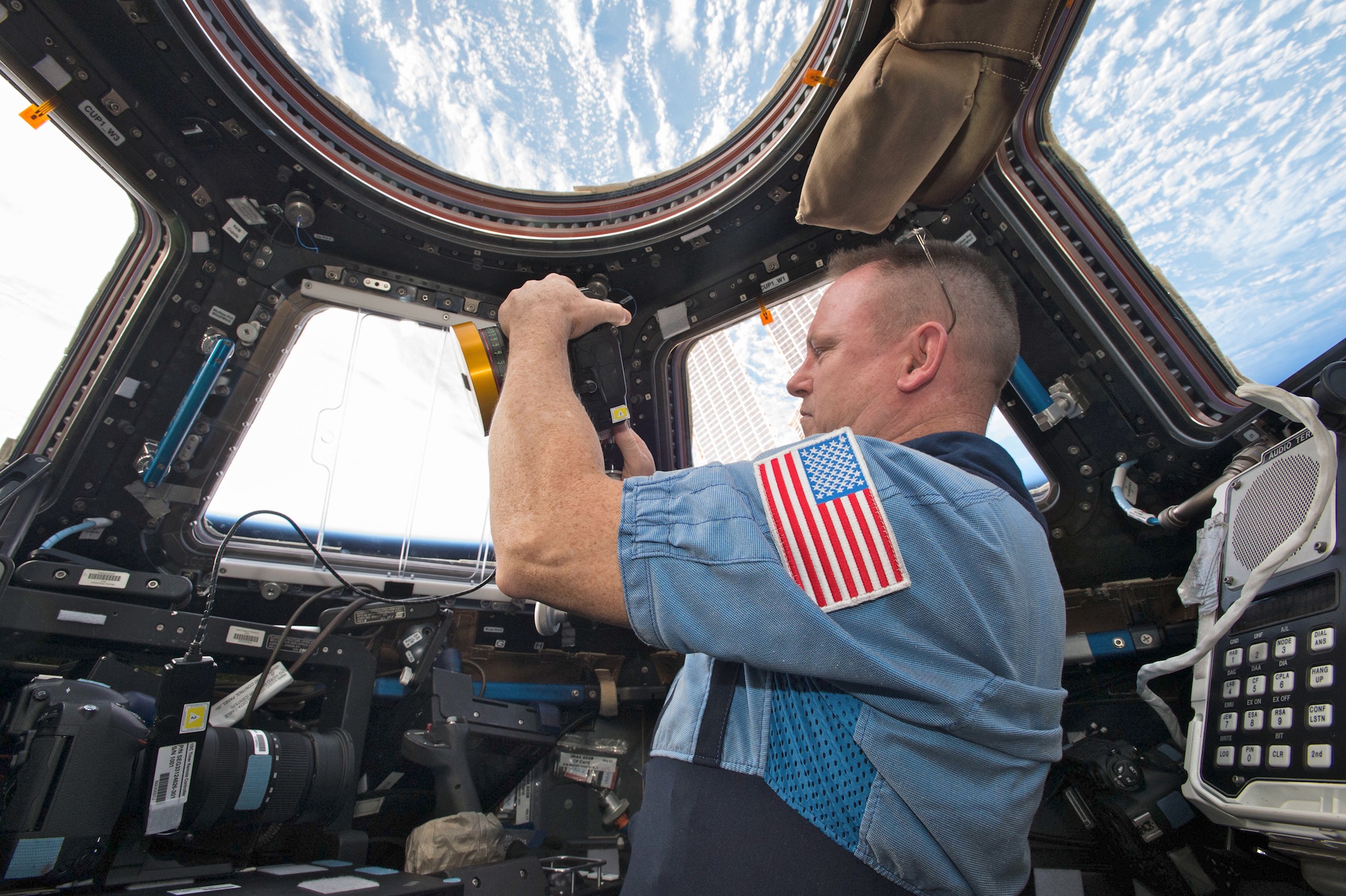Daily Business Report Feature-Aug. 8, 2016
NASA Commander Barry ‘Butch’ Wilmore shoots a scene with the IMAX camera through the window of the International Space Station’s Cupola Observation Module. (Courtesy of NASA)
Stunning Views of Earth
IMAX film offers rare glimpses of the planet
and important environmental issues
By Andrew Dyer
In the IMAX film “A Beautiful Planet,” director Toni Myers takes audiences to the International Space Station for an astronaut’s-eye-view of the earth and the environmental issues stressing its fragile biosphere.
With narration by actress Jennifer Lawrence and filmed over one year by four overlapping space station crews, “A Beautiful Planet” made its San Diego debut at the Reuben H. Fleet Science Center in Balboa Park in June.
Myers is a veteran of IMAX documentaries and her film career spans more than 40 years. Her director credits also

include IMAX films “Hubble 3D” and “Space Station 3D.”
She has worked on IMAX since its inception in the late 1960s and has been involved in IMAX space films since writing and editing the first — the 1985 classic “The Dream is Alive.”
“We put (an IMAX) theater in the National Air and Space Museum in Washington,” she said. “The first director of that museum was (Apollo astronaut) Mike Collins. When he saw IMAX, a film called ‘To Fly,’ he said it was the only way people would experience what he did going to space. We already knew that but it was good that he said it. It took 10 years (from then) to get a camera on board the space shuttle.”
Myers worked on several space films for IMAX and NASA. She said they trained 145 astronauts on 24 shuttle flights to operate the cameras. With the shuttle’s retirement the way they had been making the films, with physical film, was also retired.
“We could no longer fly IMAX film and cameras to the ISS,” she said. “We had to switch to digital.
Myers said she was astonished at the quality of the digital images despite some purists’ instance on film’s superiority.
“The blacks are as black as you can make them. The colors are vivid and there’s no bleeding,” she said. “You could even see colors in the Bahaman reefs by moonlight. It allowed us to (see) what we never would have seen on film.”
Space Station crews shot over 11.5 terabytes of data for the project, and Myers said there was so much quality footage it was difficult not to make the film feature-length. “A Beautiful Planet’s” run-time is 45 minutes.
“It was a difficult job because I had such an embarrassment of riches,” she said. “We had a specific environmental message to convey, so those automatically went into the film. We stopped shooting in November 2015, and I had to deliver the finished film by March. It was a crunch.”
Myers said she was not trying to be preachy with the film’s environmental themes and that she wanted to use the fragility of the space station as a metaphor for the earth.
“We made a film back in 1990 about the earth called “Blue Planet,’” she said. “A lot has changed. (Then) the big worry was the ozone hole, and now things have become a lot more urgent.”
From the vantage point of the ISS, audiences can see the effect humans are having on the planet.
“You can see monster pollution clouds over China and we have a large sequence on the drought in California,” Myers said. “Water is a big theme. On the other side of the world in the Himalayas, glaciers are melting. The water supply of 500 million people is being affected.”
“A Beautiful Planet” also features footage of the earth at night with city lights visible from space. Myers said energy is another theme of the film with the need to find an alternative to fossil fuels.
“There is an incredible moonlit shot of the Gulf of Mexico,” she said. “You can see Dallas, Houston and San Antonio with all the oil well flares and fracking fires arrayed around.”
Myers said that with the exception of about one minute of the film, none of what is presented is Computer Generated Imagery ( CGI) effects.
“Everything in the planetary shots in the Milky Way sequences is not CGI,” she said. “It is real data. We do these sequences at the supercomputing center at the University of Illinois. Every one of the stars in the Milky Way is a real star with a real address in three-dimensional space. That is not made-up.”
Young people are the film’s target audience and Myers said she hopes to inspire tomorrow’s problem-solvers.
“I wanted to inspire those kids,” she said, “not berate them about what terrible humans are doing to the earth. I want them to go out and find the solution to the problems we are facing.”




